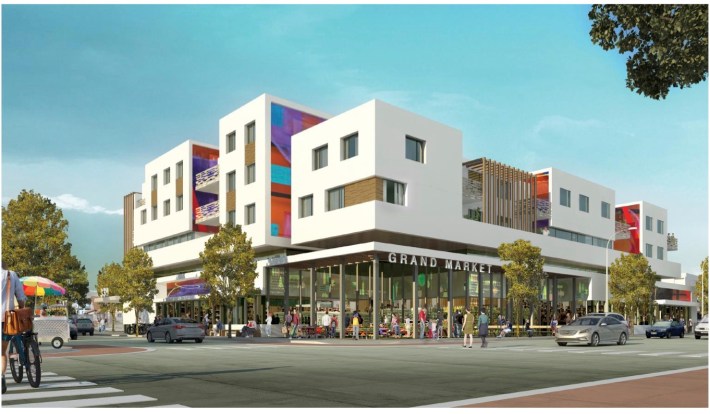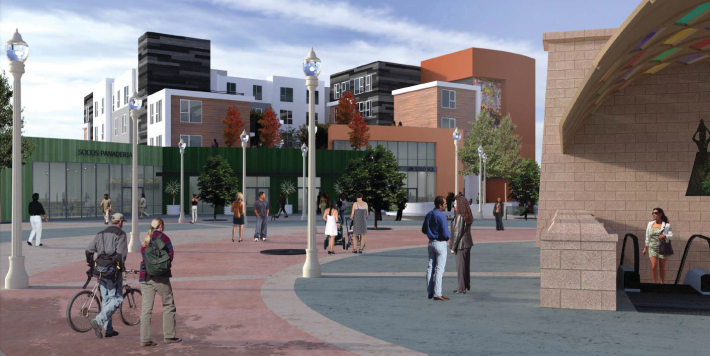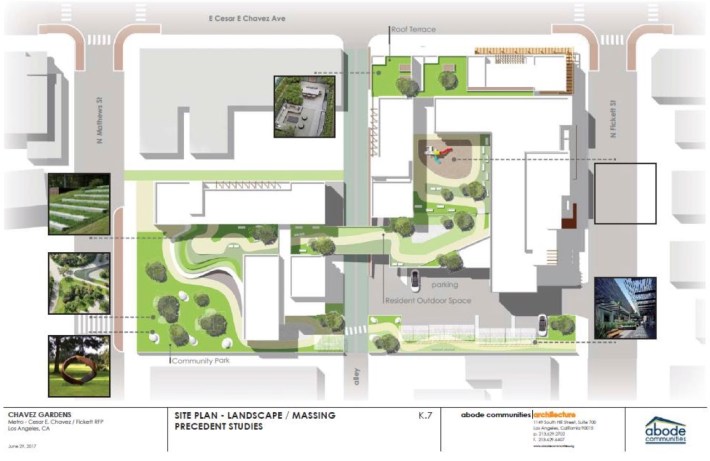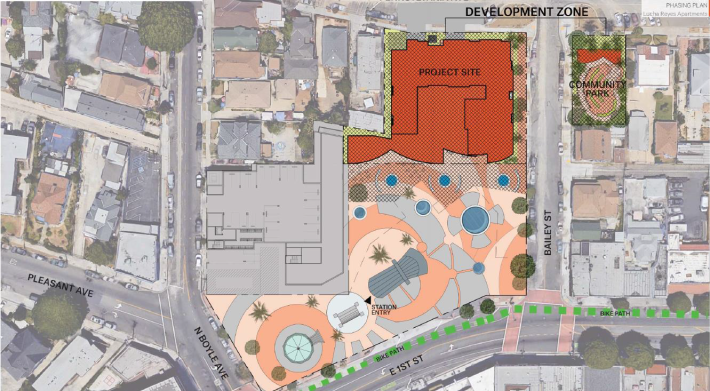On Wednesday, Metro's Planning and Programming Committee approved an 18-month Exclusive Negotiation Agreement (ENA) with the East L.A. Community Corporation (ELACC) and Abode Communities in support of their proposals for mixed-use projects on Metro-owned lots at Mariachi Plaza (above) and Cesar Chavez/Fickett (below).
Together, the two projects will bring 120 units of affordable housing for those earning between 30 and 50 percent of the Area Median Income (AMI), approximately 12,000 square feet of public park space and gardens, a grocery store (at Cesar Chavez/Fickett), a Mariachi Cultural Center (at Mariachi Plaza), retail spaces meant to be accessible to local and community-serving businesses, and community meeting rooms. [For more of a breakdown on the projects, see our coverage here.]

The final approval of the ENAs, expected to take place at the Metro Board meeting at 9 a.m. on January 25, marks the beginning of the end of Metro’s three-year effort to make amends for the firestorm it touched off at the end of 2014, when it attempted to sneak a proposal for a parking garage, medical offices, retail, and a fitness center past the community (below).
While livability advocates had fumed over the idea of an 8-story garage at a rail station, Boyle Heights residents and mariachis expressed anger over how efficiently their community and all trappings of its culture had been erased from the very place meant to celebrate both.
Why, they wondered, did Metro's vision for the future of the community seem to hinge on the removal of the families, dancers, skateboarders, mariachis, vendors, artwork, artists, and organizations that regularly lent neighbors a helping hand? And where exactly had that grassy knoll and all the picnicking white people come from?
When Metro finally held a forum to hear what the community had to say about the controversial proposal in early 2015, residents did not mince their words, asking, in essence, "Who was this project really for?"

Wednesday's brief hearing on the proposals from ELACC and Abode made clear just how far Metro had come in its effort to listen to communities.
For one, the proposed projects are far more community-serving.
Residents that had worked with Metro to create development guidelines for the sites had repeatedly stressed the importance of making any available housing units as affordable as possible. While it is getting harder to find funding that can accommodate those working steadily but informally (like vendors, who might earn between 10 and 20 percent of the Area Median Income (AMI), and mariachis), both projects offer units for those earning between 30 and 50 percent AMI. Notably, the "Lucha Reyes" proposal for Mariachi Plaza sets aside 30 units for those at 30 percent AMI and will offer 26 studios, a configuration that will keep rents low and seems intended to help mitigate the ongoing displacement of mariachis from around the plaza.

For another, the projects have the potential to aid residents in retaining ownership of the sites.
The creation of a Mariachi Cultural Center where residents can take music classes and enjoy summer programming means that, even as the area continues to grow and change, the mariachis will always have a physical, social, and cultural presence on the plaza.
Similarly, the plans to have CALÓ YouthBuild not only manage the garden but use it as a laboratory where students can earn apprenticeship certificates tied to green technologies carves out space for the first group that tends to be chased out of the public space: at-risk youth of color. Youth have long complained about being run off the plaza by law enforcement as it is. Sheriffs regularly parked at (or on, as often happened at 1st/Soto) the plaza to let youth know they were being watched, something the youth found frustrating, given how few safe public places were available to them, especially after dark.
This project not only gives the youth a safe place to be, it elevates their status to that of caretakers of an important community space and cultural and environmental innovators.

Many of those speaking up in favor of the project Wednesday touched on how important it was that Metro had shifted gears and listened to the community three years ago. But they also wanted Metro to understand the agency would have to deepen its relationship with the community for the project to be truly successful.
Metro would need to work harder to be transparent with and a partner to the community. Jason Gallegos of the Boyle Heights Neighborhood Council noted that the council had only heard about Metro's intention to approve the ENAs via email blast while organizer Rose Miranda chastised the agency for not having translation services available at the hearing.
Metro would also be expected to work with local businesses, as Un Solo Sol owner Carlos Ortez suggested, to ensure that the projects strengthened their ability to retain a foothold in the area instead of undermining it.
And street vendors - the most vocal contingent of speakers - asked that Metro work with them to make both the projects and transit hubs more welcoming to the vendors who were the backbone of the Boyle Heights community. Citing concerns over how the pilot project at MacArthur Park was going and the way that it left vendors not participating in the project more vulnerable to harassment, they asked that Metro be cognizant both of how much vendors struggled to stay afloat and how much they contributed to street life.
One of the complaints that went unanswered was lodged by a homeowner concerned about the lack of parking incorporated into the project. It was a question that had come up many times during the development of the guidelines for the sites. Facilitators had explained that the high cost of parking spaces - as much as $40,000 per space for underground parking - would result in higher construction costs, making the apartments and retail spaces less affordable. So, it was in the best interest of the project to have a minimum of parking.
The other question that remained - although largely unspoken - was whether the units would be occupied by Boyle Heights residents. Fair housing rules require that the application process be open to all - not just those in Boyle Heights. But as the community continues to be squeezed by gentrification and rents continue to rise on already overcrowded and/or makeshift poor quality housing, many current residents are in the market for stable, affordable, quality units where they don't have to fear approaching landlords about necessary repairs or worry about landlords jacking up the rent by $800. But the overwhelming demand for affordable housing and the difficulty so many have in making the minimum required income, limiting the number of people in their family that will live in a unit, and/or getting proper documentation of their histories can work against them. The lack of any real resolution to these issues is one of the key reasons residents continue to have concerns about who Metro projects are meant to serve.

In calling for a vote, County Supervisor Metro Boardmember Hilda Solis took a moment to commend the more robust process Metro had undertaken and the more appropriate set of proposals it had generated. She then acknowledged the challenges the vendors had voiced, apologized in Spanish for the lack of translation services, and thanked the community for coming out in support of moving the projects forward.
The ENAs were approved by the committee and will go before the full Board for a vote on January 25 at 9 a.m. Once approved by the Board, the developers will immediately begin a last round of community engagement to gather feedback that will help shape the final form of the plans. Those finalized proposals will go before the Board for approval in mid-2019.
See our previous coverage of Metro’s interactions with the community around the fate of Metro-owned lots here:
- January, 2018: Metro Board to Consider Developers for Mariachi Plaza and Cesar Chavez/Fickett Joint Development Sites
- January, 2017: Metro Committee to Adopt Mariachi Plaza Development Guidelines Wednesday
- March, 2016: Residents Debate Priorities for Mariachi Plaza at Second Design Workshop
- March, 2016: Planning for Mariachi Plaza Begins Again; How it Will Tie in to Other Area Projects Remains Unclear
- December, 2015: Metro Moves Affordable Housing Projects in Boyle Heights Forward, Returns Grocery Store Project to Drawing Board
- October, 2015: Boyle Heights to See Improvements in Phase Two of the Eastside Access Project
- August, 2015: Privileging Form (and Speedy Implementation) over Function Yields Semi-Obsolete Street Furniture in Boyle Heights
- March, 2015: Boyle Heights Youth Research Community Challenges, Find Proposed TOD Solutions Don’t Go Far Enough to Help Neediest
- January, 2015: Youth Rise Above Heckling to Win Concession for Community on Metro Projects at Neighborhood Council Meeting
- January, 2015: Finally Given a Platform, Boyle Heights Speaks Out on Metro’s Mariachi Plaza and Affordable Housing Plans
- November, 2014: Metro Postpones Approving ENA for Mariachi Plaza, Gets Blasted for Having it on Agenda in First Place
- November, 2014: Dupont-Walker, Community Press Metro on Surprising Changes Slated for Mariachi Plaza, Demand More Outreach
- September, 2013: Eastside Access Project Takes Another Step Forward, Experiences Growing Pains
- February, 2013: Developers Introduced at Metro Open House to Reshape Empty Lots
- December, 2012: “Starting from the Beginning” for Some Metro Owned Sites in Boyle Heights
- December, 2012: Boyle Heights Community, Metro Clash at Meeting Over Development at MTA Owned Property







